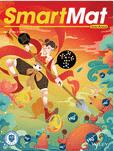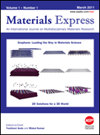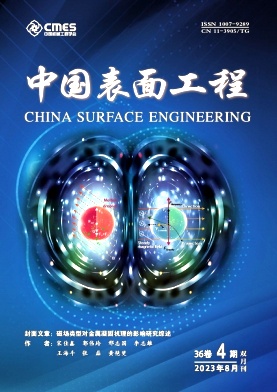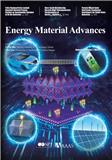SmartmatSCIE
国际简称:SmartMat 参考译名:智能材料
- 基本信息:
- ISSN:2688-819X
- E-ISSN:2688-819X
- 是否OA:开放
- 是否预警:否
- TOP期刊:是
- 出版信息:
- 出版地区:Australia
- 出版商:Wiley
- 出版语言:English
- 研究方向:Multiple
- 评价信息:
- 影响因子:15.3
- CiteScore指数:21.9
- SJR指数:4.332
- SNIP指数:2.046
- 发文数据:
- Gold OA文章占比:87.13%
- 研究类文章占比:66.20%
- 年发文量:71
英文简介Smartmat期刊介绍
Smartmat is an English academic journal dedicated to the field of smart materials. Since its inception, it has been committed to reporting on cutting-edge research achievements in the field of smart materials, and in 2023, it was awarded the Chinese national journal number, marking its official recognition and status in the academic community at home and abroad. As an academic journal under the supervision of the Ministry of Education, the journal carries the important mission of enhancing the academic level and international influence in the field of intelligent materials in China. It aims to promote academic exchanges and cooperation among domestic and foreign scholars in the field of smart materials by publishing high-quality academic papers in English, and to drive technological innovation and industrial development in this field.
The readership of this journal mainly includes researchers, scholars, graduate students, and professionals in the field of smart materials and related industries. It provides a high-level academic exchange platform for these readers to share the latest research results and technological advancements, promoting the collision and innovation of academic ideas. The publication of magazines not only helps to enhance the academic level of China's smart materials field, but also further promotes international cooperation and exchanges in this field, playing a more important role for China in the global competition in the field of smart materials.
期刊简介Smartmat期刊介绍
《Smartmat》是一本材料科学优秀杂志。致力于发表原创科学研究结果,并为材料科学各个领域的原创研究提供一个展示平台,以促进材料科学领域的的进步。该刊鼓励先进的、清晰的阐述,从广泛的视角提供当前感兴趣的研究主题的新见解,或审查多年来某个重要领域的所有重要发展。该期刊特色在于及时报道材料科学领域的最新进展和新发现新突破等。该刊近一年未被列入预警期刊名单,目前已被权威数据库SCIE收录,得到了广泛的认可。
该期刊投稿重要关注点:
Cite Score数据(2024年最新版)Smartmat Cite Score数据
- CiteScore:21.9
- SJR:4.332
- SNIP:2.046
| 学科类别 | 分区 | 排名 | 百分位 |
| 大类:Engineering 小类:Mechanics of Materials | Q1 | 8 / 398 |
98% |
| 大类:Engineering 小类:Chemistry (miscellaneous) | Q1 | 3 / 111 |
97% |
| 大类:Engineering 小类:General Materials Science | Q1 | 14 / 463 |
97% |
CiteScore 是由Elsevier(爱思唯尔)推出的另一种评价期刊影响力的文献计量指标。反映出一家期刊近期发表论文的年篇均引用次数。CiteScore以Scopus数据库中收集的引文为基础,针对的是前四年发表的论文的引文。CiteScore的意义在于,它可以为学术界提供一种新的、更全面、更客观地评价期刊影响力的方法,而不仅仅是通过影响因子(IF)这一单一指标来评价。
中科院SCI分区Smartmat 中科院分区
| 大类学科 | 分区 | 小类学科 | 分区 |
| 材料科学 | 1区 | CHEMISTRY, MULTIDISCIPLINARY 化学:综合 MATERIALS SCIENCE, MULTIDISCIPLINARY 材料科学:综合 | 1区 1区 |
中科院分区表 是以客观数据为基础,运用科学计量学方法对国际、国内学术期刊依据影响力进行等级划分的期刊评价标准。它为我国科研、教育机构的管理人员、科研工作者提供了一份评价国际学术期刊影响力的参考数据,得到了全国各地高校、科研机构的广泛认可。
中科院分区表 将所有期刊按照一定指标划分为1区、2区、3区、4区四个层次,类似于“优、良、及格”等。最开始,这个分区只是为了方便图书管理及图书情报领域的研究和期刊评估。之后中科院分区逐步发展成为了一种评价学术期刊质量的重要工具。
JCR分区Smartmat JCR分区
| 按JIF指标学科分区 | 收录子集 | 分区 | 排名 | 百分位 |
| 学科:CHEMISTRY, MULTIDISCIPLINARY | ESCI | Q1 | 15 / 230 |
93.7% |
| 学科:MATERIALS SCIENCE, MULTIDISCIPLINARY | ESCI | Q1 | 28 / 438 |
93.7% |
| 按JCI指标学科分区 | 收录子集 | 分区 | 排名 | 百分位 |
| 学科:CHEMISTRY, MULTIDISCIPLINARY | ESCI | Q1 | 18 / 231 |
92.42% |
| 学科:MATERIALS SCIENCE, MULTIDISCIPLINARY | ESCI | Q1 | 30 / 438 |
93.26% |
JCR分区的优势在于它可以帮助读者对学术文献质量进行评估。不同学科的文章引用量可能存在较大的差异,此时单独依靠影响因子(IF)评价期刊的质量可能是存在一定问题的。因此,JCR将期刊按照学科门类和影响因子分为不同的分区,这样读者可以根据自己的研究领域和需求选择合适的期刊。
本刊中国学者近年发表论文
-
1、Mixed ion-electron conducting Li3P for efficient cathode prelithiation of all-solid-state Li-ion batteries
Author: Li, Jing; Liu, Dan; Sun, Han; Qu, Deyu; Xie, Zhizhong; Tang, Haolin; Liu, Jinping
Journal: SMARTMAT. 2023; Vol. , Issue , pp. -. DOI: 10.1002/smm2.1200
-
2、Optically modulated dual-mode memristor arrays based on core-shell CsPbBr3@graphdiyne nanocrystals for fully memristive neuromorphic computing hardware
Author: Wang, Fu-Dong; Yu, Mei-Xi; Chen, Xu-Dong; Li, Jiaqiang; Zhang, Zhi-Cheng; Li, Yuan; Zhang, Guo-Xin; Shi, Ke; Shi, Lei; Zhang, Min; Lu, Tong-Bu; Zhang, Jin
Journal: SMARTMAT. 2023; Vol. 4, Issue 1, pp. -. DOI: 10.1002/smm2.1135
-
3、Nanostructures and catalytic atoms engineering of tellurium-based materials and their roles in electrochemical energy conversion
Author: Li, Tiantian; Deng, Yuting; Rong, Xiao; He, Chao; Zhou, Mi; Tang, Yuanjiao; Zhou, Hongju; Cheng, Chong; Zhao, Changsheng
Journal: SMARTMAT. 2023; Vol. 4, Issue 1, pp. -. DOI: 10.1002/smm2.1142
-
4、Self-healable, recyclable, ultrastretchable, and high-performance NO2 sensors based on an organohydrogel for room and sub-zero temperature and wireless operation
Author: Ding, Qiongling; Zhou, Zijing; Wang, Hao; Wu, Zixuan; Tao, Kai; Yang, Bo-Ru; Xie, Xi; Fu, Jun; Wu, Jin
Journal: SMARTMAT. 2023; Vol. 4, Issue 1, pp. -. DOI: 10.1002/smm2.1141
-
5、Emulsion-templated synthesis of 3D evaporators for efficient solar steam generation
Author: Chen, Jinxing; Lee, Michael; Qiu, Yinghua; Wu, Chaolumen; Li, Bo; Yin, Yadong
Journal: SMARTMAT. 2023; Vol. 4, Issue 2, pp. -. DOI: 10.1002/smm2.1140
-
6、Stretchable, self-healable, and breathable biomimetic iontronics with superior humidity-sensing performance for wireless respiration monitoring
Author: Ding, Qiongling; Wang, Hao; Zhou, Zijing; Wu, Zixuan; Tao, Kai; Gui, Xuchun; Liu, Chuan; Shi, Wenxiong; Wu, Jin
Journal: SMARTMAT. 2023; Vol. 4, Issue 2, pp. -. DOI: 10.1002/smm2.1147
-
7、Insights into enhanced electrochemiluminescence of a multiresonance thermally activated delayed fluorescence molecule
Author: Yang, Liuqing; Dong, Lihui; Hall, David; Hesari, Mahdi; Olivier, Yoann; Zysman-Colman, Eli; Ding, Zhifeng
Journal: SMARTMAT. 2023; Vol. 4, Issue 2, pp. -. DOI: 10.1002/smm2.1149
-
8、A large-scalable spraying-spinning process for multifunctional electronic yarns
Author: Gan, Linli; Zeng, Zhen; Lu, Haojie; Li, Daiqi; Wei, Ke; Cai, Guangming; Zhang, Yingying
Journal: SMARTMAT. 2023; Vol. 4, Issue 2, pp. -. DOI: 10.1002/smm2.1151
投稿常见问题
-
请问这本期刊属于什么级别呢?可用于职称评定吗?
一般刊物只分省级、部级、核心,期刊本身是没有几类划分的,具体是几类或者几级,您可以对照单位的分类文件确认一下。Smartmat杂志是由Wiley出版的一本SCIE,可用于职称评定。
-
你们能够提供哪些核心期刊的咨询服务?
大多数核心期刊我们都是可以提供咨询服务的。目前核心期刊主要分为以下几类:1.国内核心:按照权威度排序,社科类:南大核心>南大扩展>北大核心>科技核心 按照权威度排序。工科类:CSCD C库>CSCD E库(相当于CSCD扩展)>北大核心>科技核心。2.国外核心(全英文):按照权威度排序为:SSCI=SCI>EI>ISTP=CPCI。
-
想快速发表,可以加急吗?
为了确保您的职称评定顺利进行,我们建议提前半年到一年开始准备,这样能够保证有充足的时间来处理所有相关事宜。如果客户需要加急服务,我们会与杂志社进行沟通,以确定是否可以提供加急服务。请注意,如果确认可以加急,可能会收取一定的加急费用。
-
你们提供的服务可以确保稿件被发表吗?
期刊编辑会综合考虑多个因素,如发表范围、学术价值和原创性等,对稿件进行综合评估。尽管任何机构均无法保证每篇稿件都会被发表,但我们可以用专业知识和丰富经验,协助您理解并遵循期刊的发表要求,从而提高您的稿件被发表的机率。
-
请问期刊发表的费用如何?
期刊发表的费用因期刊不同而异。根据您的需求,我们会为您推荐性价比最高的期刊,并提供专业的期刊供您选择。一般来说,只要符合职称要求,大多数作者都会选择性价比最高的期刊作为意向期刊进行重点咨询。我们会为您提供详细的期刊信息和费用说明,以确保您能够做出明智的选择。
-
如果稿件被拒,未能成功发表,费用是否可以退还?
一般来说,我们推荐的期刊和您的专业方向、文章情况都是匹配的,极少出现稿件被拒的情况。如果稿件被拒,期刊编辑会提供详细的拒稿信和建议,以帮助您了解拒稿原因并改进您的稿件。关于退款政策,具体情况可能因期刊不同而异,请您咨询我们的工作人员以获取详细信息。
免责声明
本站合法持有《出版物经营许可证》,仅销售经国家新闻出版署批准的合法期刊,不是任何杂志官网,不涉及出版事务。本站仅提供有限咨询服务,需要用户自己向出版商投稿且没有绿色通道,是否录用一切以出版商通知为准。提及的第三方名称或商标,其知识产权均属于相应的出版商或期刊,本站与上述机构无从属关系,所有引用均出于解释服务内容的考量,符合商标法规范。本页信息均由法务团队进行把关,若期刊信息有任何问题,请联系在线客服,我们会认真核实处理。若用户需要出版服务,请联系出版商
相关期刊推荐
热门期刊推荐
-
Acs Applied Electronic Materials
中科院 3区 JCR Q1
-
Materials Characterization
中科院 2区 JCR Q1
-
Progress In Organic Coatings
中科院 2区 JCR Q1
-
Surfaces And Interfaces
中科院 2区 JCR Q1
-
Advanced Optical Materials
中科院 2区 JCR Q1
-
Materials
中科院 3区 JCR Q1
-
Acs Applied Nano Materials
中科院 2区 JCR Q2
-
Materials Today Sustainability
中科院 3区 JCR Q1





